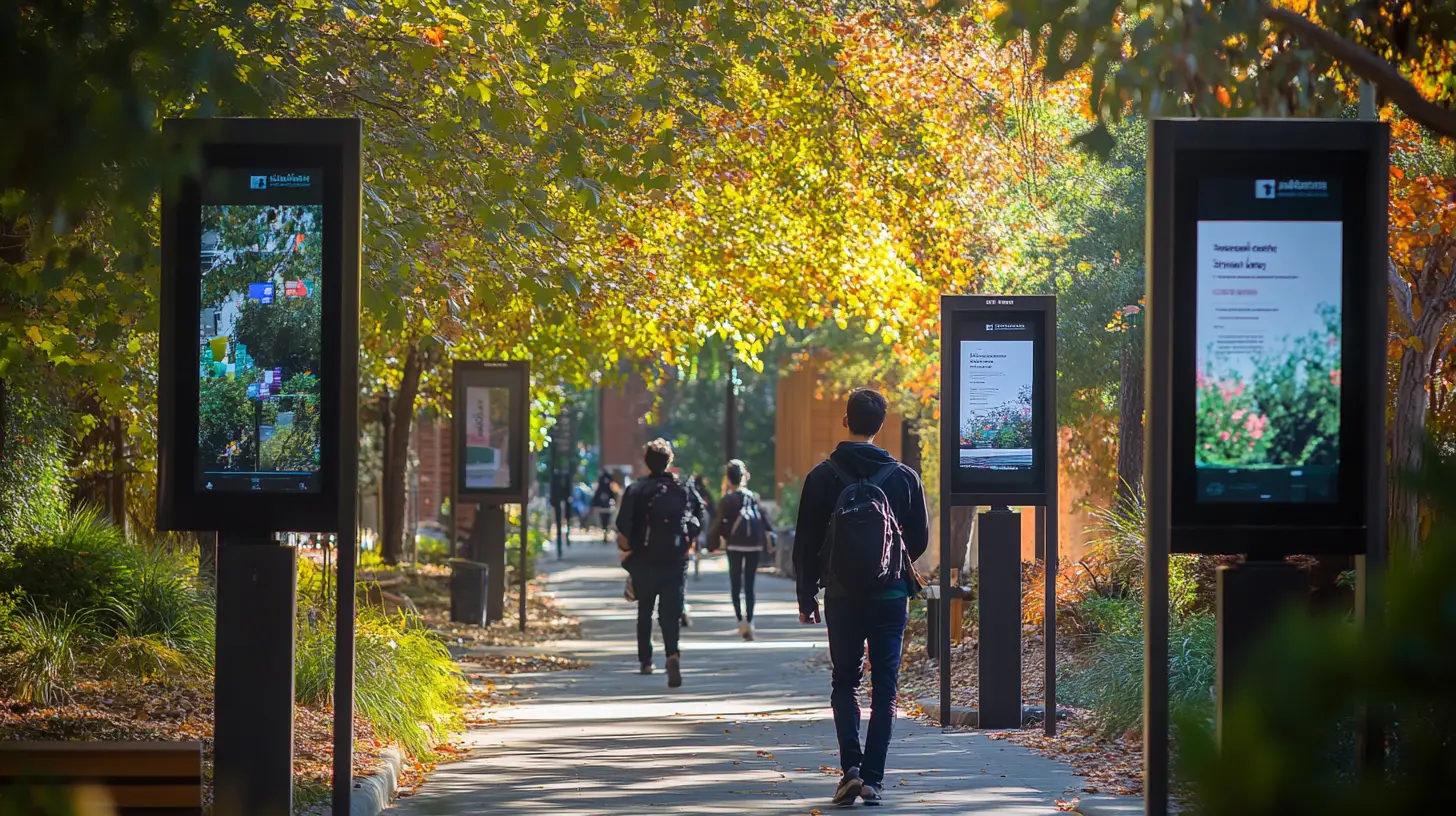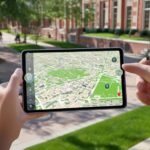Integrating campus maps with mobile apps can revolutionize your campus navigation and enhance user experience. Start with detailed planning and use an experienced indoor mapping provider. Accurately digitize 2D maps and convert them to 3D for better visual appeal. Incorporate real-time positioning and A-B wayfinding for efficient routes. Enhance your maps with smart search features, virtual tours, and customization options. Integrate real-time alerts for safety, monitor occupancy, and use location sharing for improved communication. Embrace these features to create an indispensable campus navigation tool. There’s more to discover about making your app an essential part of campus life.
Key Takeaways
- Use an experienced indoor mapping software provider for accurate and scalable map integration.
- Ensure real-time positioning and A-B wayfinding for seamless user navigation.
- Implement smart search and virtual tour features to enhance user engagement.
- Integrate real-time alerts and emergency notifications for improved campus safety.
- Geo-reference and convert 2D floor plans to 3D maps for precise indoor positioning and visual appeal.
Campus Navigation App Development
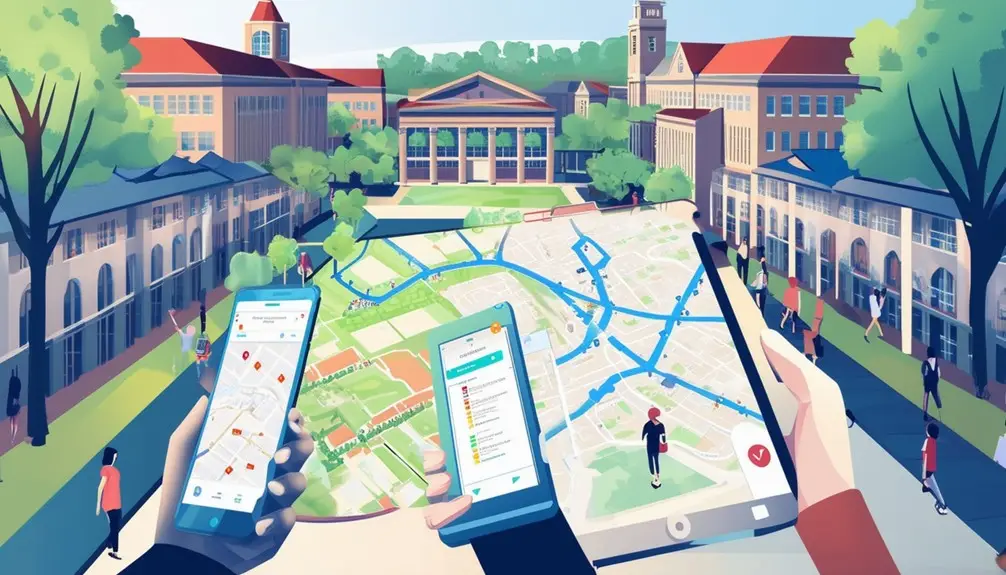
When creating a campus navigation app, integrating it with existing campus applications is key to guaranteeing a seamless user experience and accessibility. You’ll need to make sure that your app smoothly connects with other campus systems, such as student portals and event calendars, to provide a thorough tool for users.
Start by focusing on creating an interactive map that offers precise indoor wayfinding solutions. This map should include detailed floor plans of all campus buildings, allowing users to navigate effortlessly from one location to another. Incorporating features like real-time positioning and A-B wayfinding will greatly enhance the user experience, making it easier for students, faculty, and visitors to find their way around.
Choosing an experienced indoor mapping software provider is important. They can offer the expertise needed to develop a scalable and customizable campus navigation solution. Make sure your provider supports strong developer tools and ongoing map maintenance, so your app remains accurate and up-to-date.
Detail-oriented planning and clear objectives are essential. Outline the specific needs of your campus and ensure that your interactive map aligns with these requirements. With the right integration and development strategy, your campus navigation app will become an indispensable tool for everyone on campus.
Data Collection and Digitization
Gathering accurate 2D maps and floor plans of all campus buildings forms the backbone of a reliable indoor mapping system. You need these detailed floor plans to make sure that every facility, classroom, and point of interest is included. This extensive data allows students to locate their destinations efficiently using an indoor mapping tool.
Start by collecting the most up-to-date 2D-floor plans of each building. Make sure that every map is geo-referenced to scale, which is vital for precise indoor positioning. Accurate geo-referencing means your mobile devices can guide students with pinpoint accuracy, enhancing their overall navigation experience.
Once you have the 2D maps, upload them into your system. Consider converting these 2D floor plans into 3D maps to add visual appeal and make navigation more intuitive. A seamless integration of 3D maps ensures that students can better visualize their routes and destinations.
Connect multiple buildings within your indoor mapping tool. This connection facilitates smooth indoor-outdoor navigation, making it easier for students to move between different parts of the campus. By focusing on these main steps, you’ll create a highly efficient indoor navigation system for mobile devices.
Custom Campus Map Features
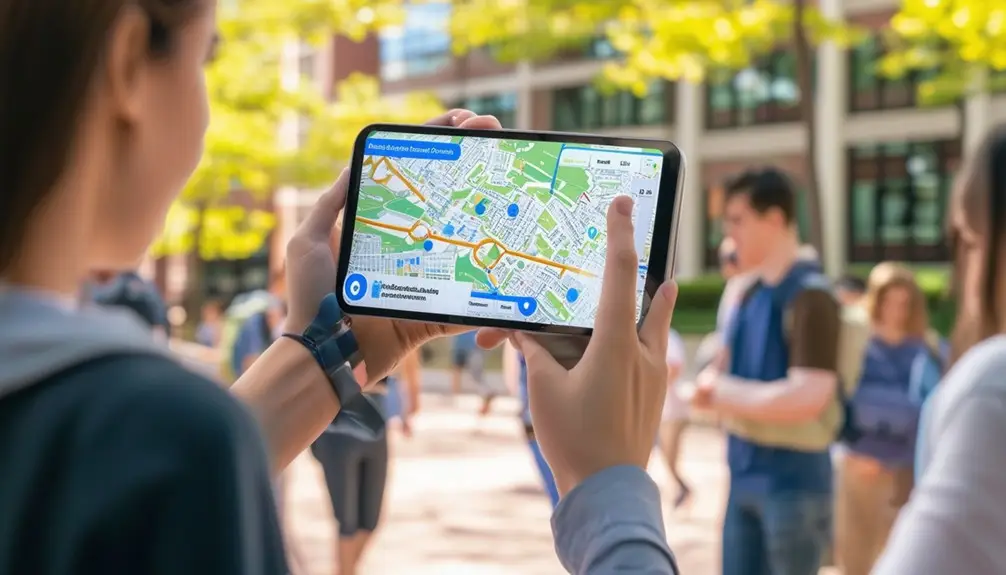
Custom campus map features greatly enhance the navigation experience by incorporating real-time positioning, A-B wayfinding, smart search, virtual tours, and contact monitoring. When you integrate an interactive campus map into your mobile application, you empower users to find their way around both indoor and outdoor environments with ease. Real-time positioning allows users to see their exact location on the map, making it simple to navigate unfamiliar territories.
A-B wayfinding helps users plot the most efficient routes from one point to another, while smart search features enable quick access to important locations like lecture halls, cafeterias, and administrative offices. Virtual tours offer a unique, immersive experience, allowing prospective students and visitors to explore the campus from anywhere in the world.
Seamless integration with existing campus apps or the development of a custom mobile application ensures that these features work smoothly across various devices and software platforms. By focusing on customization and scalability, you provide a personalized mapping experience that adapts to the evolving needs of your campus community. Ultimately, these features notably enhance user engagement and overall satisfaction, making it easier for everyone to find their way around the campus.
Safety and Monitoring Tools
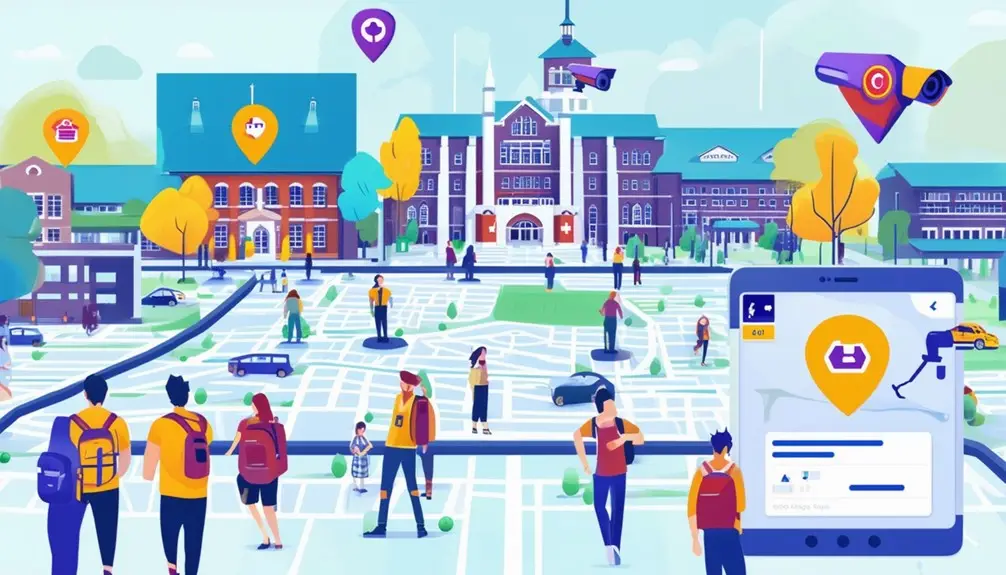
Safety and monitoring tools greatly improve campus security by offering real-time alerts, occupancy tracking, and contact monitoring to guarantee a safer environment for everyone. With indoor positioning, you can implement contact monitoring software that notifies individuals of potential COVID-19 exposure, ensuring timely health measures. Real-time alerts provided by these tools allow for quick responses to emergencies, enhancing overall campus safety.
Monitoring occupancy levels helps enforce social distancing measures and optimize the placement of services. By identifying high-traffic areas, you can better manage crowd control and allocate resources more effectively. Additionally, usage patterns identified by these tools guide budget allocations, ensuring funds are directed where they are needed most.
Key benefits of safety and monitoring tools include:
- Real-Time Alerts: Immediate notifications for emergencies, enabling swift action.
- Indoor Positioning: Precise location tracking for effective contact monitoring and exposure notifications.
- Occupancy Levels: Accurate tracking to enforce social distancing and manage space utilization.
- High Traffic Areas: Identification and management for improved crowd control and resource allocation.
Enhanced Communication and Engagement
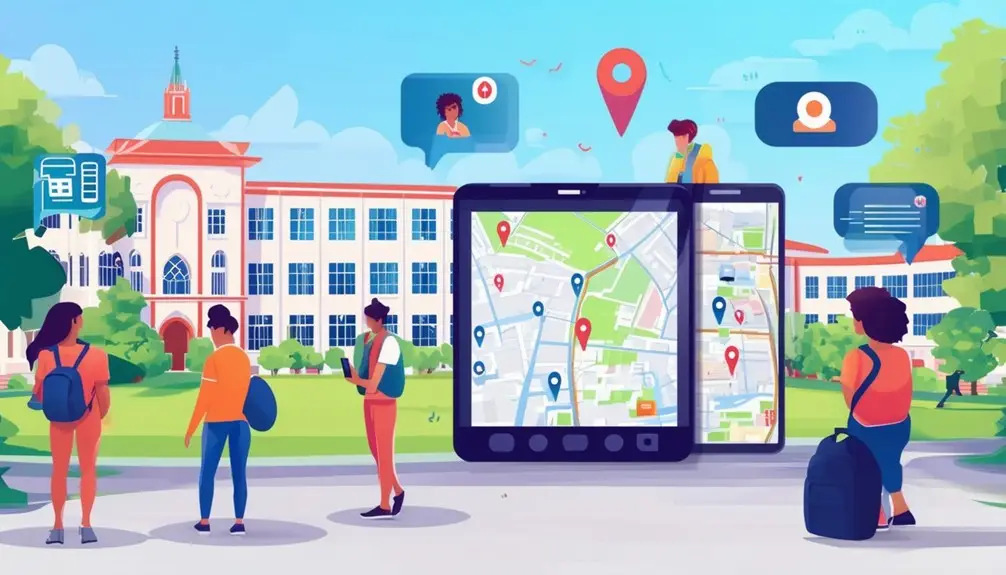
Blue Dot technology revolutionizes campus communication and engagement by providing real-time location sharing and targeted notifications. In higher education, this technology can help students find their way around the campus more efficiently. The map allows for accurate location tracking, making it simpler for students to locate meeting rooms and other parts of the campus.
By integrating Blue Dot technology, institutions can add new features to their mobile apps that streamline communication. For example, students can receive alerts about events or promotions near their current position, encouraging participation and driving foot traffic to campus activities. Additionally, timely emergency notifications guarantee that students are promptly informed about any safety concerns.
Here’s a detailed breakdown of how Blue Dot technology enhances campus engagement:
| Feature | Benefit | Use Case |
|---|---|---|
| Real-time location sharing | Enhances wayfinding and safety | Finding meeting rooms, emergency help |
| Targeted notifications | Drives engagement and participation | Alerts for nearby events or promotions |
| Precise tracking | Improves campus experience | Navigating areas of the campus |
| Emergency notifications | Ensures prompt safety alerts | Immediate response to incidents |
Conclusion
So, you’ve just developed the ultimate campus navigation app, digitized data like a tech wizard, and installed custom map features that would make even Google Maps jealous. You’ve also added safety tools that could probably detect a squirrel’s sneeze and communication features that rival social media platforms. Bravo! Now, sit back and watch as students navigate campus like it’s a high-stakes treasure hunt, all while you bask in the glory of your technical genius.
Frequently Asked Questions
Can Campus Maps in Mobile Apps Be Updated in Real-Time?
Imagine receiving vital updates instantly. Yes, you can update campus maps in mobile apps in real-time, ensuring you always have the latest building locations, route changes, and event info at your fingertips, enhancing navigation and accessibility.
What Platforms Are Supported for Campus Map Mobile Apps?
You can use campus map mobile apps on iOS and Android platforms. They support real-time updates and GPS navigation. Confirm your device meets the app’s system requirements for seamless performance and accurate location services.
How Secure Is the Data Collected by Campus Map Apps?
You’ll find that campus map apps prioritize data security. They often use encryption, secure servers, and regular updates to protect your information. Always check the app’s privacy policy and security features for specific details.
Are There Offline Features Available in Campus Map Mobile Apps?
Yes, many campus map mobile apps offer offline features. You can download maps for offline use, ensuring you won’t get lost even without internet access. Just make sure to update the app regularly for the latest information.

